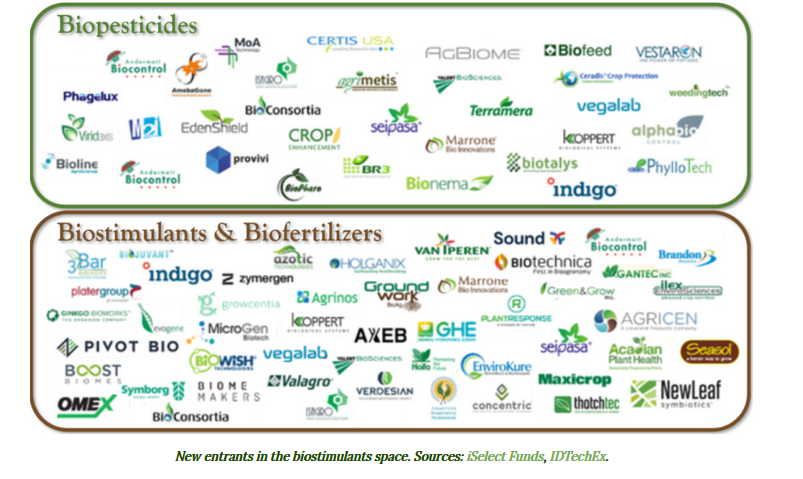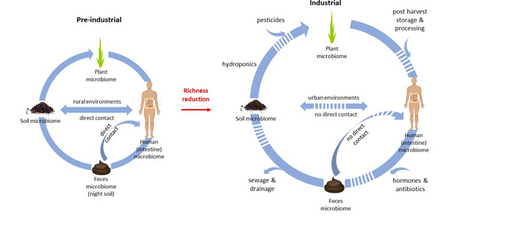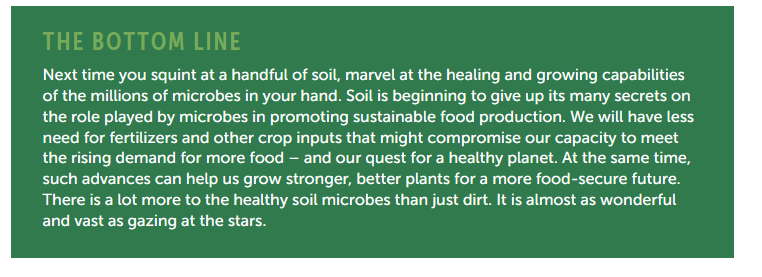Saving Our Soil…One Billion Microbes at a Time

Lucy M. Stitzer is the founder and editor of Dirt-To-Dinner. Its mission is to help consumers better understand how their food is grown and processed, and why this is important to them and their families. Learn more here: www.dirt-to-dinner.com
Pouring algae on the soil, sequencing soil DNA, and measuring soil diversity are just a few of the new technologies used to keep our soil from becoming just ‘dirt’. And it seems as though diversity is the key. When I hold a teaspoon of healthy soil in my hand I squint and try to see the billions of microbes. Apparently, in this little amount there are more microbes than all 7.8 billion people on earth today. This handful has greater diversity than all the animals and insects in the Amazon Rainforest. This is a powerful group made even more exciting when you think they originated from our celestial bodies.
Since the beginning of time, these soil microorganisms are fungi, insects, bacteria, algae, and more than happily coexist in the soil. They control soil pathogens, reduce disease outbreaks, keep plants nutritious and resilient, give plants the power to pull carbon out of the air, make land less prone to wind and water erosion, clean and filter water, and are a source of human medicines.
You have likely read about the projected increase of the global population to 9 billion people in just 30 years. That means more fruits, vegetables, and row crops needed to feed more animals and more humans. To achieve this growth, the traditional thought has been that farmers will need more and more pesticides and fertilizer to eliminate bugs and increase their yields. Or do they?
Think of the microbiome in the soil like the one in your gut. Similar to your health, plants need diversity in the soil to keep you healthy and strong. Microbial technology is a serious solution that uses bacteria, fungi, viruses, protozoans, and yeasts instead of conventional agrochemicals.
Companies in this niche produce biostimulants. These include biopesticides, which are natural materials like canola or baking soda that eliminate pests, and biofertilizers, natural fertilizer compounds such as manure, algae, or decayed material that increase the availability of nutrients to the plants.
Additionally, since microbial crop protection poses fewer risks using than conventional pesticides, the EPA generally requires less data and has shorter review times before the various solutions can be used in the field. This reduces the timeline to development by years and the cost of product development by millions of dollars.
According to Research and Markets, the global agricultural microbial market is expected to grow at a compounded annual growth rate of 12.5% and reach $11 billion by 2025 from approximately $6 billion in 2020.
Innovations in the microbiome tech space have to address the challenges of soil needs. The goal is to increase yield and reduce pests, and weeds with less chemical inputs – all while enhancing the soil microbiome. While this is a highly fragmented market, it is dominated by just a few players.
Here are four examples of new technologies that make our soil healthier…
1. AgBiome prevents pests, fungal pathogens, and weeds with designer soil microbes. Founded in 2017, the tagline reads “Better Microbes. Better Crops. Better World.” On March 23rd, Mosaic Fertilizer Company and AgBiome announced a collaboration to develop biological alternatives for soil health.
AgBiome is sequencing a library of microbes sourced from environmental samples from across the globe. As of today, the North Carolina company has more than 80,000 sequenced microbials, 3,500 of which are targeted toward controlling insects. Their technology can discover and target microorganisms and proteins that kill insect pests, fungal pathogens, and weeds. From there, they can create custom soil microbe “cocktails” that serve as a natural pest control solution for farmers.
For instance, Azomar one of their water-soluble products controls insects on crops from sucking and chewing on plant leaves. It absorbs into the plant tissue and when the insect invades – it dies. Another product Lektivar, naturally controls mold and pathogens on produce such as blueberries, potatoes, carrots, and apples.
2. Biome Makers measures the biological quality of soil to deliver agronomic insights to farmers. Based in Spain and purchased by Bayer Crop Science in 2018, the company was created to solve a fundamental problem facing the future of food: how do we recover the microbial diversity in today’s modern agriculture system?
Using an AI system, Biome Makers assesses the health of a field based on a farmer’s current practices as well as the soil functionality for any crop. What is the right soil microbiome community for a specific farm and farmer?
Now farmers can understand what works well and how it affects their soil’s health. It’s about measuring crop health and functional biodiversity by using DNA sequencing and intelligent computing.
Their team reads more like a Silicone Valley group with experts in genetics, software engineering, microbiology, agronomy, and data science. We are not in Kansas anymore…
3. Pivot Bio provides a clean alternative to synthetic nitrogen fertilizers. In April 2020, the company raised $100 million co-led by Breakthrough Energy and Temasek. Their technology reduces nitrogen fertilizer and increases crop yields.
Fully half of the world’s food supply is dependent on synthetic nitrogen fertilizer, yet overuse, misuse, and runoff can bring serious environmental impacts such as dead zones and C02 emissions. Our atmosphere is 78% nitrogen – and the only crops that can take it out of the air and convert it into a nutrient are soybeans, alfalfa, and cowpeas.
Wheat, corn, and rice don’t have this ability – therefore they need fertilizer. As Pivot Bio explains: “Nitrogen is essential to life. It’s a building block of proteins, DNA and amino acids. When plants have the right amount of nitrogen, they grow well and yield abundantly. Pivot Bio makes nitrogen fixation as natural as breathing for the microbe. Microbes inhale nitrogen gas from the atmosphere and release ammonia to plants. Enabling nitrogen-producing microbes as a crop nutrition tool for farmers will transform agriculture.”
4. MyLand replicates algae in native soil to grow as fertilizer. “Building strength beneath the surface,” explains Board Member, Bill Buckner, in reference to the company’s purpose. MyLand takes live, native microalgae from the farm to improve soil health, increase crop yields, and capture carbon.
Each farm has its own naturally specific algae – just like we have our own gut microbiome. MyLand technicians go out and take samples and isolate which algae are the most suitable for multiplication. They grow the algae in small vessels with lights and correct temperature. They make millions of cells and it is put back in the soil through the farmer’s irrigation system.
As a result, farmers use approximately 25% less fertilizer, 15% less water and reduce tillage by 40%. Voila, yield increases by about 25% and revenue by 40%.
Beyond farming and onto human health
Direct contact with the soil is key. When my oldest son was just a toddler, he was my garden helper. He would happily eat handfuls of dirt and my pediatrician assayed my worries and told me it was good for him. Now I understand why. As humans have evolved over time, we have had a close relationship with the earth first through hunter-gatherers then through farming, and now to our children crawling and running around the garden.
Humans and soil share common bacteria such as lactobacilli which breaks down our food and soil’s organic matter. We can even look to soil to give us new antibiotics that would kill multidrug-resistant pathogens such as MRSA.
But for more than half the global population living in cities and suburbs, this gut connection to the soil is missing. We primarily receive our microbiomes from the food we eat.
The chart here illustrates the difference in human contact with the soil from pre-industrial days to today.
Beyond farming and onto human health
Direct contact with the soil is key. When my oldest son was just a toddler, he was my garden helper. He would happily eat handfuls of dirt and my pediatrician assayed my worries and told me it was good for him. Now I understand why. As humans have evolved over time, we have had a close relationship with the earth first through hunter-gatherers then through farming, and now to our children crawling and running around the garden.
Humans and soil share common bacteria such as lactobacilli which breaks down our food and soil’s organic matter. We can even look to soil to give us new antibiotics that would kill multidrug-resistant pathogens such as MRSA.
But for more than half the global population living in cities and suburbs, this gut connection to the soil is missing. We primarily receive our microbiomes from the food we eat.
The above chart illustrates the difference in human contact with the soil from pre-industrial days to today.
Hot topic: The link between soil health to human health
We eat what we sow, so to speak. The essential nutrients, such as hydrogen, oxygen, carbon, that we need to thrive as humans come from the soil (originally from the stars). In speaking with Dr. Stephen Wood, Sr. Scientist of Agriculture and Food Systems at The Nature Conservancy and Lecturer at Yale, “Very simply, plants receive their micro and macronutrients from the soil.
“In order for humans to thrive, we receive those same nutrients that come from the plants.” Dr. Wood highlighted studies undertaken in parts of Africa that show a correlation between low selenium and zinc in the soil with low levels in the blood of the local population who ate the local rice.
But he is quick to point out that this is not as simple as low levels of nutrients in plants equate to low levels of nutrition in humans. While there is emerging research, the actual evidence where “soil management impacts human health through changes in crop nutrient densities is small.”
In Africa, where nutrition and food scarcity are real issues, studies have been done but the correlation is not always strong. The chart below shows the inconsistencies of zinc in the soil versus in the corn, cowpea, millet, and sorghum.
Even so, we want healthy, not degraded soil, to produce a higher yield of crops to feed a growing population. It is because of the nutrients in the soil that the plants receive their nutrients. While industrial fertilizer gives specific nutrients to help crops grow, increasing the organic matter helps build the microbes in the soil to increase yield.
Regenerative agriculture practices such as cover cropping, no-till farming, and adding livestock from time to time all help increase the diversity and abundance of microorganisms.
How do changes in microbial soil affect the future?
There are benefits to increasing the microbial content of soil – but it is not a perfect science. The added microbes only live in the soil for about three months and can easily be taken over by other microbes. They are hard to apply – which is tough for small holder farmers. Finally, if too much is applied for too long, they can saturate the soil of salts and nutrients.
That said, the technologies keep improving. If we can grow our food with healthier soil and less fertilizer runoff and create better nutrients in our plants and soil we will have a healthier planet and healthier people.











